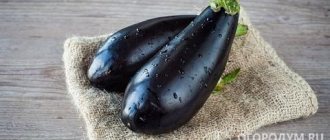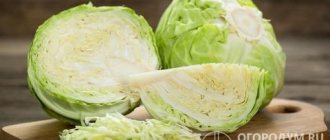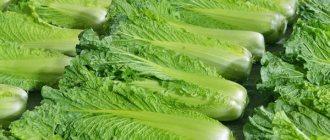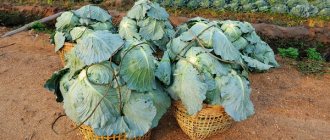It is difficult to organize long-term storage of cabbage in a city apartment. A small volume of vegetables can even be placed in the refrigerator if everything is organized correctly.
Several methods are suitable for this, allowing you to save even chopped or defective vegetables.
We will tell you in the article how to properly and in what form (fresh, stewed, cut, etc.) it is best to store cabbage in the refrigerator, how long the shelf life is and how to extend it.
Storage options
You can store white cabbage at home fresh, just in heads, providing the plants with certain conditions. This method is available to residents of private houses and city apartments.
Find out how to store other types of cabbage at home in winter: cauliflower, Chinese cabbage, kohlrabi, broccoli.
Cabbage can also be processed. Some recipes allow you to use the vegetable for 2-3 weeks, others – 1-2 years. The most common ways to store cabbage:
- pickling or pickling;
- pickling;
- freezing;
- drying.
How to store cabbage at home is up to you, but first let’s find out which varieties are suitable for this, how and when to harvest.
Varieties and their purpose
All varieties of white cabbage are divided into early, middle and late.
- Vegetables of early varieties ripen quickly. You can harvest them from mid-June, but they won’t last long. They can be stored fresh in a cellar or refrigerator for up to 1 month.
- Mid-season varieties begin to be cut in July or August. Most of them won't last long. They are intended for fresh consumption and, with rare exceptions (the Zosya variety), for short-term maintenance of 2-2.5 weeks.
- For fresh storage in winter, choose mid-late and late-ripening varieties. They can last 6-8 months, that is, until a new harvest of early vegetables appears.
The best varieties of cabbage for storage are shown in the table:
Varieties with a shelf life of 6-8 months (according to the State Register of the Russian Federation). Click on the image to enlarge (opens in a new window)
Tip of the day
Cabbage is a highly zoned crop. Before choosing a variety or hybrid for planting, find out if it is recommended for your region.
Results
We looked at the expiration dates and storage rules for the most popular varieties of cabbage. As theory shows, storing vegetables and dishes containing them is not an easy matter. In practice, everything is much simpler. Follow storage rules, do not eat expired food and do not use spoiled heads of cabbage for cooking.
Remember:
- That a vegetable affected by pests is not intended for storage;
- About the importance of periodic inspection of long-stored heads of cabbage;
- About the need for timely removal of dry and darkened leaves.
Harvest
Late cabbage varieties have a long growing season. There is a danger in this. If you do not have time to harvest from the garden before frost -5 ° C, then the frozen vegetable will not be stored.
But there is no need to rush through this procedure. The heads of cabbage must be fully formed and mature. The holiday of Intercession (October 14) is the time when you need to harvest cabbage from the garden.
Remove late cabbage on dry, sunny days when the air temperature does not rise above 5-7 °C.
- When ready for harvesting, carefully separate the heads of cabbage from the stalk with a knife or hatchet, leaving 5 cm. Or pull out the plants by the roots. Try not to damage the waxy coating that protects them from premature deterioration.
- Place the cut or plucked heads into bags, baskets or boxes and take them away from the garden. If you plan to store cabbage for a long time, it is better not to tear off the top leaves - they will gradually fall off on their own.
- When the crop is harvested, carefully inspect each head. Healthy, dense heads of cabbage weighing 2 kg or more are suitable for winter storage. Small specimens are best used for canning.
- The heads must be free of mechanical damage, cracks and traces of pest activity. Set aside heads of cabbage that are cut too high or poorly for processing and consumption first. Immediately place selected copies in storage.
We answer the question: when to buy cabbage for winter storage?
For storage, it is better to grow it yourself. This way you will be confident in the product. But if this is not possible, you should purchase vegetables for the winter during the period of mass harvesting of late-ripening varieties, that is, not earlier than the end of September.
Fresh storage
Preserving fresh cabbage until spring is easy. On the scale of a personal farm or cottage, the harvest does not exceed 100-200 kg, so we will talk about saving exactly this volume of production.
You should decide on the method and place of storage before harvesting.
Conditions
To ensure your vegetables overwinter safely, follow these rules:
- Provide the cabbage heads with a temperature range from 0 to 1 °C.
- Maintain storage humidity at 90-95%.
- Equip the room with good ventilation or ventilate it.
- Store varieties with different shelf life separately.
- Periodically review your bookmarks and promptly remove damaged copies.
When the storage regime is created incorrectly, the plant either quickly withers or rots just as quickly.
We answer the question: is it possible to store cabbage at sub-zero temperatures?
Not recommended. At temperatures below 0 ⁰C, the vegetable loses its taste, freezes slightly and, as a result, begins to rot.
In a private home, the easiest way to store cabbage is in the cellar. If you don’t have one, an insulated shed or garage will do, or you can also keep it underground. But these options are not without their drawbacks. It is difficult to maintain temperature and humidity there.
In the cellar and apartment
Here are 3 ways to store cabbage in the cellar:
- If there are few heads with roots, hang them head down from the ceiling of the storage room. Plants should not touch each other. Use slats, ropes or hooks to secure vegetables.
- Store larger quantities in mini-containers. Large slatted boxes or bulky plastic containers are suitable. Place a few vegetables in each and put them in storage.
- Keep large harvests on pallets. Stack the heads of cabbage, leaving gaps between them for ventilation. Layer the rows with polyethylene so that a vegetable that has begun to rot will not infect neighboring ones.
Maintaining ideal conditions in an apartment is much more difficult. At room temperature, the heads of cabbage will not last even a week, and you will still notice the smell from them. All that remains is to store cabbage on the balcony if it is glazed and insulated.
Vegetables can be placed on shelves or kept in drawers. To prevent the heads of cabbage from spoiling for a long time, wrap them tightly in cling film, leaving no air bubbles.
Watch this short video on how to store cabbage in garbage bags:
We answer the question: how to store red cabbage?
Red cabbage can be stored fresh in the same way as white cabbage. The principles are the same. Other red varieties last even longer than white ones.
In a refrigerator
It is better to store fresh cabbage whole heads in the lower compartment of the refrigerator or in the freshness zone. It specially creates the best conditions for vegetables, fruits and berries: a temperature of about 0 ° C and optimal humidity.
To store vegetables:
- Take strong, healthy heads of cabbage. There is no need to remove the top leaves; when putrefactive microflora appears, they will be the first to take the blow, and you will have time to notice it.
- Place each head of cabbage in a plastic bag or wrap tightly in cling film to prevent condensation.
- Put the vegetables in the refrigerator.
With this storage method, the heads will remain fresh for 1-2 months, and stored varieties for up to 6 months.
You can do the same with unused halves and quarters of forks. Wrap them in packaging and put them in the refrigerator.
Cut vegetables are stored no worse than whole heads of cabbage - up to 3 months. However, the cut area dries out, so dried areas will need to be cut off before use.
Saving conditions
What are the storage periods and conditions for white cabbage? This vegetable can be stored for 4 to 5 months in suitable conditions. The best temperature is considered to be from -1 to 0 °C, stable air humidity should be 90-95%.
If cabbage is stored at above-zero temperatures, then the air moisture content should be 80-85%. During storage, you need to occasionally check the vegetable and remove spoiled leaves. If you wrap the cabbages tightly in newsprint, they can be kept in a cool, dry area. They need to be placed at a short distance from each other.
The lifespan of cabbage depends on the storage conditions and its variety. Whatever storage method you choose, it is recommended to leave the stalks longer.
Canned storage
Canning is convenient, tasty and healthy. Its main ingredient will be substandard plant specimens. The easiest way to prepare cabbage for the winter is in jars. They can be stored both in the apartment and in the house. A cellar or refrigerator will do.
The fresh cabbage selected for processing should be pre-prepared - remove the top dry outer leaves, remove the stalk and cut out the damaged areas.
Do you know that…
Pickling varieties have thick, fleshy leaves. They have a lot of juice and few veins. These are the ones that need to be selected for conservation. Dry and low-juicy varieties for long-term storage are not suitable for preparations.
Varieties that are suitable for fermentation (according to the State Register of the Russian Federation). Click on the image to enlarge (opens in a new window)
Pickling
Sauerkraut is considered a classic of the genre. It's the easiest to prepare. You will need these ingredients:
- cabbage – 2 kg;
- carrots – 1 pc.;
- salt – 1-1.5 tbsp. l.
Chop the cabbage and place it in a bowl. Add salt and stir. To make the cabbage crispy, you don’t need to mash it. Leave the slices for 0.5 hours so that the juice comes out. Add grated carrots and mix everything again. Then pack everything tightly into 3-liter jars and place them in a warm place. Periodically pierce the contents with a stick reaching to the bottom to remove carbon dioxide, otherwise the cabbage will taste bitter.
After 2-3 days, place the jars in the refrigerator to continue cold fermentation, and after another 2-3 days the dish will be ready. Store it in a cool, dark place.
Pickling
Pickled cabbage “pelyustka” turns out to be very tasty. Loose, unformed heads of cabbage are ideal for its preparation. Watch the recipe in the video:
Do you know that…
Sauerkraut is a unique product. She does not lose vitamin C for a long time. And it does not spoil thanks to lactic acid, which appears during the fermentation process and blocks the development of harmful bacteria.
A little about cabbage
Cabbage was considered the main vegetable in Europe before the potato was discovered. It does not apply to overseas vegetables. The past of cabbage is very bright and rich. She was even depicted on ancient paintings. This vegetable began its journey from Ancient Greece and then spread throughout Europe. Cabbage dishes are present in any European national cuisine.
Cabbage contains a lot of protein, much more than other vegetables. Proteins are considered essential amino acids. They are necessary for the growth and reconstruction of tissue, the thyroid gland, adrenal glands and kidneys, and hematopoiesis.
Cabbage has a long shelf life, so the vitamins it contains can be preserved until the next harvest. This vegetable contains an attractive vitamin U, with the help of which colitis, intestinal sluggishness and gastritis, duodenal and stomach ulcers are treated. It contains no less vitamin C than citrus fruits. And vitamin K heals wounds, normalizes metabolism, forms healthy teeth and bones, and helps the liver function.
Nutritionists recommend eating sauerkraut, as it is considered extremely healthy.
Practical freezing
Freezing vegetables is a labor-intensive technology for preserving food. In this way, you can prepare greens, some vegetables and fruits for the winter. But is it possible to freeze cabbage in the freezer? Yes, as semi-finished products for preparing first and second courses.
The easiest way to prepare sliced cabbage is:
- Take fresh, tight heads of cabbage, remove the outer leaves, and cut out the stalk.
- Rinse the head under running water and let it dry.
- Cut the vegetable into small strips.
- Place the prepared cuts in plastic containers or plastic bags.
- Place the workpiece in the freezer compartment of the refrigerator.
Cabbage can be stored in the freezer longer than in the vegetable compartment - from 6 months. up to 1 year. You can use it immediately; there is no need to wait until the product thaws.
Frozen cabbage is not suitable for salads, as it loses its appearance and crunch. But for preparing hot dishes - just right
You can also freeze cabbage individual leaves. Such preparations are suitable for preparing cabbage rolls. To do this, use summer varieties or loose, loose heads of late ripening.
- For whole cabbage, remove the top leaves and the stem.
- Rinse and dry the vegetable.
- Carefully separate the heads of cabbage into individual leaves.
- Place the workpiece into bags in portions.
- Place the cabbage leaves in the freezer.
Frozen cabbage must thaw before cooking. To do this, place it on the bottom shelf of the refrigerator. When it softens, the dish can be cooked.
A big plus in favor of freezing cabbage for cabbage rolls is that the vegetable does not need to be boiled first. The leaves are quite soft after defrosting.
Note to the hostess
Not all varieties behave “persistently”. Some spread out after defrosting, and you won’t be able to roll the cabbage rolls. If you don’t know how cabbage will behave, then immediately roll up the cabbage rolls and freeze them.
Useful tips
Let's look at some useful tips for storing sauerkraut, allowing you to maintain the quality of the product at a high level and maximize its shelf life:
Since the main value of sauerkraut is the content of large amounts of vitamin C, as well as coarse fibers that ensure normal digestion and metabolic processes in the body, it is necessary to take precautions so that the beneficial substances are not destroyed during storage. To do this, the workpieces must be covered with brine, and the product is removed from the liquid only before serving.
If the liquid does not cover all the cabbage, it is recommended to use a press that will press down the main product, in which case the brine will cover it completely. Regular sugar will help prevent the product from becoming acidic; it is added as a preservative, which stops the fermentation processes that occur in an acidic environment. Sugar is poured directly onto the top layer of cabbage. Table vinegar can be used for the same purposes, but it should be added directly to the brine, thoroughly mixing the contents of the container. The vinegar additive may slightly change the taste of the product, so it should be added carefully and in minimal doses.
A good preservative is vegetable oil, which is poured onto the surface of the brine. It allows you to block the access of oxygen to the main product and protects against the effects of pathogenic microorganisms that provoke rapid rotting and spoilage of food. If the workpiece is slightly acidic, it can be used to prepare dishes undergoing heat treatment; in this case, the cabbage should be thoroughly washed and sprinkled with 1 tsp. Sahara. To protect the workpieces from mold fungi, add mustard powder or mustard seeds bound in a gauze bag to the container. Such products have an antiseptic effect and prevent the development of harmful microorganisms. You can extend the shelf life of cabbage by adding cranberries to the container, which are a natural preservative and prevent rapid deterioration of the preparation. Horseradish is a good product for protecting products from rapid spoilage, which prevents the development of bacteria and fungi, and also adds a piquant taste and aroma to pickles. It is added to the finished product after ripening, so as not to interrupt the fermentation processes.
Thus, the duration of storage of sauerkraut directly depends on the container, place and conditions that were organized
To ensure that the product is suitable for use for as long as possible, it is recommended to pay attention to the information in the article











